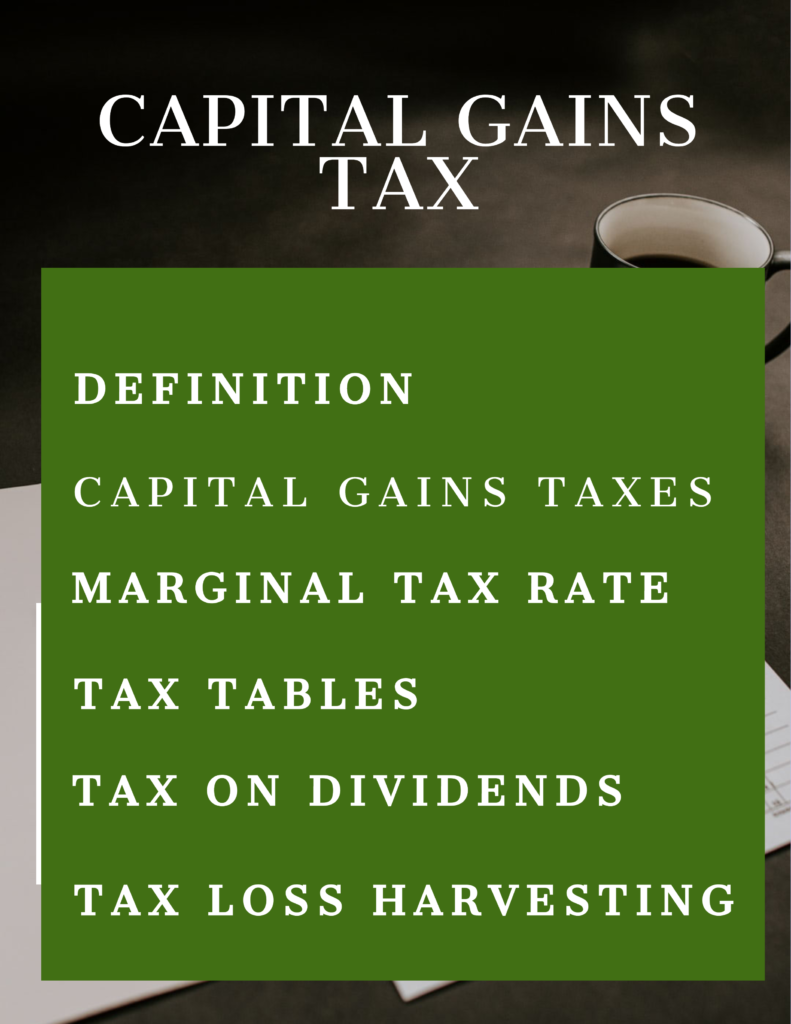

Definition of Capital Gains
Capital gain happens when you sell a Stock for more than what you paid for it. The formula is:
Capital gain = Selling price – Purchase price
For example, you bought 500 shares in Company A for $10 a share. Your purchase price is $5,000. You sold it for $15 a share. Your selling price is $7,500. Thus, the Capital gain is $2,500.
Definition of Marginal Tax rate
The marginal tax rate is the rate on the last dollar of income earned. If a single filer is earning $100,000 per year, his marginal tax rate would be 24%. However, that 24% tax rate will only be applied to earnings above $85,525. The first $9,875 would be taxed at 10%, the next bracket until $40,125 would be taxed at 12%, the next bracket until $85,525 would be taxed at 22%.
Capital Gains taxes
There are two types of Capital gains taxes:
Short-term capital gains tax: If you purchase shares and sell it within one year, the tax on the profits will be the short-term capital gains tax.
Long-term capital gains tax: If you purchase shares and sell it after one year, the tax on the profits will be the long-term capital gains tax.
Usually the short-term capital gains tax will be your marginal tax rate and the long-term capital gains tax will be 0%, 15% or 20% based on the filing status and taxable income.
Tax table for the long-term capital gains tax
| Tax rate | Single | Married, filing jointly | Married, filing separately | Head of household |
| 0% | Up to $40,000 | Up to $80,000 | Up to $40,000 | Up to $53,600 |
| 15% | $40,001 to $441,450 | $80,001 to $496,600 | $40,001 to $248,300 | $53,601 to $469,050 |
| 20% | More than $441,450 | More than $496,699 | More than $248,300 | More than $469,050 |
Taxes on the Dividends
If you hold stocks for a period of more than 60 days during the 121-day period that begins 60 days before the ex-dividend date, then the dividends you receive are called “Qualified dividends”. The qualified dividends are subjected to the same 0%, 15%, or 20% maximum tax rate that applies to the net capital gains.
Tax loss harvesting
If you have shares that have gone down in value, and you are facing a loss, you could sell those shares and use the loss amount to offset gains you have in other positions. Say you had a profit of $2000 in Company A. You will have to pay the Capital gains tax. But you have a position in Company B and a loss of $1000 and you analyze that there is no way you could recover from that, you could see that position and use the negative $1000 to offset your gain, thereby you would only pay the Capital gains tax for $1000.
If you only have capital losses and no gains, you can offset up to $3,000 in non-investment income. Losses over $3,000 carry forward over your lifetime to offset any future capital gains or other income. One thing to keep in mind is that you cannot purchase the same securities within a 30-day period. You can purchase it after 30 days though. This is called the wash sale rule period. So, at least 60 days before year end, analyze your portfolio and plan for tax loss harvesting.
Federal Income Tax tables
Tax table for Single filers for the year 2020:
| Taxable Income | Tax Rate |
| Not over $9,875 | 10% of the taxable income |
| $9,875 to $40,125 | $987.50 plus 12% of the excess over $9,875 |
| $40,125 to $85,525 | $4,617.50 plus 22% of the excess over $40,125 |
| $85,525 to $163,300 | $14,605.50 plus 24% of the excess over $85,525 |
| $163,300 to $207,350 | $33,271.50 plus 32% of the excess over $163,300 |
| $207,350 to $518,400 | $47,367.50 plus 35% of the excess over $207,350 |
| Over $518,400 | $156,235 plus 37% of the excess over $518,400 |
Example:
If a single person earns $100,000 per year, the tax would be calculated as follows:
The income would fall under the category $85,525 to $163,300 with a marginal tax rate of 24%.
Tax owed = $14,605.50 + 0.24 * (100,000 – 85,525) = $18,079.50
Tax table for Married filing jointly for the year 2020:
| Taxable Income | Tax Rate |
| Not over $19,750 | 10% of the taxable income |
| $19,750 to $80,250 | $1,975 plus 12% of the excess over $19,750 |
| $80,250 to $171,050 | $9,235 plus 22% of the excess over $80,250 |
| $171,050 to $326,600 | $29,211 plus 24% of the excess over $171,050 |
| $326,600 to $414,700 | $66,543 plus 32% of the excess over $326,600 |
| $414,700 to $622,050 | $94,735 plus 35% of the excess over $414,700 |
| Over $622,050 | $167,307.50 plus 37% of the excess over $622,050 |
Example:
If a Married person filing jointly earns $100,000 per year, the tax would be calculated as follows:
The income would fall under the category $80,250 to $171,050 with a marginal tax rate of 22%.
Tax owed = $9,235 + 0.22 * (100,000 – 80,250) = $13,580
Tax table for Head of households for the year 2020:
| Taxable Income | Tax Rate |
| Not over $14,100 | 10% of the taxable income |
| $14,100 to $53,700 | $1,410 plus 12% of the excess over $14,100 |
| $53,700 to $85,500 | $6,162 plus 22% of the excess over $53,700 |
| $85,500 to $163,300 | $13,158 plus 24% of the excess over $85,500 |
| $163,300 to $207,350 | $31,830 plus 32% of the excess over $163,300 |
| $207,350 to $518,400 | $45,926 plus 35% of the excess over $207,350 |
| Over $518,400 | $154,793.50 plus 37% of the excess over $518,400 |
Example:
If a head of the household earns $100,000 per year, the tax would be calculated as follows:
The income would fall under the category $85,500 to $163,300 with a marginal tax rate of 24%.
Tax owed = $13,158 + 0.24 * (100,000 – 80,250) = $17,898
Tax table for Married filing separately for the year 2020:
| Taxable Income | Tax Rate |
| Not over $9,875 | 10% of the taxable income |
| $9,875 to $40,125 | $987.50 plus 12% of the excess over $9,875 |
| $40,125 to $85,525 | $4,617.50 plus 22% of the excess over $40,125 |
| $85,525 to $163,300 | $14,605.50 plus 24% of the excess over $85,525 |
| $163,300 to $207,350 | $33,271.50 plus 32% of the excess over $163,300 |
| $207,350 to $311,025 | $47,367.50 plus 35% of the excess over $207,350 |
| Over $311,025 | $83,653.75 plus 37% of the excess over $311,025 |
Example:
If a Married person is filing separately and earns $100,000 per year, the tax would be calculated as follows:
The income would fall under the category $85,525 to $163,300 with a marginal tax rate of 24%.
Tax owed = $14,605.50 + 0.24 * (100,000 – 85,525) = $18,079.50
